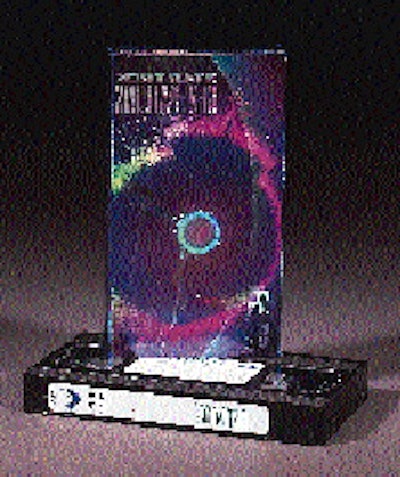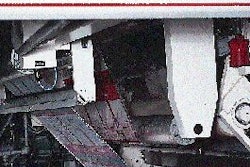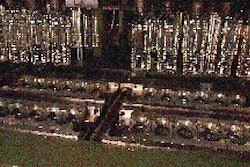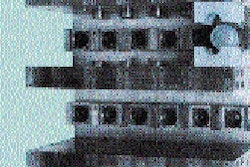A recent advance in holographic technology provided Los Angeles-based Paramount Home Video with unprecedented design flexibility for a new video cassette package. Paramount employed the decorating technology on a paperboard sleeve for its Star Trek Generations video released in February, retailing for $14.95. The sleeve contains the translucent faces of the two famous starship captains joined by a striking holographic burst or "explosion." Reflecting the ambient fluorescent store lighting that the package was designed for, the burst radiates outward (or inward, depending on the angle of approach) as shoppers move nearer the package, snaring their attention. What makes the decoration unique is that the burst is really two images in one: a holographic image that blends into a four-color offset-printed version of the same image. One picks up where the other leaves off, thanks to the tight registration of the process printing to the holography. Offset printing to holography registration has never been done before in a packaging application, says Brian Monaghan, sales vp of Pennsylvania Pulp & Paper (Glenside, PA), originator of the hologram. Paramount Home Video was pleased with the result. "We felt that this process showed the Star Trek art off to the best advantage," says Hollace Brown, senior vp, advertising & sales promotion at Paramount. High-resolution image To create the hologram, PP&P first creates a holographic image from computer artwork by using a laser to mark the image in a high-resolution dot matrix (10ꯠ pixels per sq", each pixel a full holographic "prism") on a photo-sensitive glass plate. The holographic artwork consists of the aforementioned burst and a full-coverage star field background that covers all sides of the box. The glass plate undergoes further processing to create a positive that is then shipped to Van Leer Metallized Products (Franklin, MA). That firm uses the positive to emboss the image nine-up on paper coated with a proprietary lacquer. The paper is then vacuum metallized to create Van Leer's HoloPRISM® holographic paper, which is completely recyclable and repulpable, according to Monaghan. PP&P then laminates the holographic paper to 18-pt coated-one-side SBS board in roll form. Once laminated, the holographic paperboard is topcoated with a water-based proprietary acrylic coating that makes it suitable for offset lithography. PP&P uses optical slitting and sheeting devices to cut the laminated web into sheets, at an accuracy of ±1/64". The optical slitting and sheeting is the key to allowing graphics to be printed in register to the hologram. To permit accurate slitting, a "racing stripe" is incorporated into the hologram along the edge of the web in a continuous line. Since it's part of the holographic master, it's always a consistent distance from that line to the holographic image of the burst. That line, which reflects light back at a certain angle, is "read" by the slitter. "If you slit along that line, as the line weaves back and forth, the knives are moving back and forth with it," explains Monaghan. An eye-mark incorporated into the master that repeats after each impression provides a similar cue to the sheeting device that cuts across the web direction. Once the material is sheeted, Shorewood Packaging (New York, NY) offset prints it with graphics generated by the same computer file that was used for the holographic image to help ensure accurate registration. Translucent inks are used to allow the star field background to show through. On the back, Shorewood prints spot opaque white in two passes to block out the hologram in two areas where photo stills from the movie are printed. After the opaque white is allowed to dry, the stills are printed via four-color offset in one pass. Next, the printed sheets receive a UV coating for gloss and for more controlled "slip." This aids machinability on the cassette insertion line. Sheets are then die-cut, folded and glued into boxes. Paramount wouldn't comment on costs or volumes, other than acknowledging an upcharge over standard cassette boxes. However, Monaghan says over 1.2 million of the packages were produced, suggesting that full-coverage, print-registered holography can be a viable technology for a mass market application. The limited-run package has sold out, which Paramount's Hollace Brown attributes partly to the packaging.



























